Custom Design
CRM Implementation: Building a Customer Data Foundation for Sustainable Growth
Have you ever seen your salespeople struggle with disparate customer data, rendering it impossible to deliver consistent experiences? That is precisely where strategic CRM implementation comes in. Most companies implement CRM software but lack the underlying strategy that turns it from a rudimentary tool into a growth engine.
We observe this trend over and over again—firms spend heavily on sophisticated CRM systems but don’t get their full worth from them because they treat implementation as a technical project instead of a strategic business effort. Proper CRM implementation lays the customer data foundation that drives everything from sales process automation to customer-driven decision making.
In this guide, we’ll take you through what strategic CRM implementation really is, why it’s important for your business success, and give you a workable model for developing a customer data foundation that produces lasting results.

Table of Content
What is CRM Implementation?
CRM implementation is the structured process of setting up, configuring, and integrating a Customer Relationship Management system to align with your specific business objectives and processes. It goes far beyond simply installing software or migrating data.
Strategic CRM implementation involves carefully planning how customer information will flow through your organisation, designing the processes that will capture and utilise this data, and creating the technical and human systems needed to maintain data quality over time.
Unlike traditional technology deployments that focus primarily on technical requirements, proper CRM implementation centres on business outcomes—like increasing customer retention, improving sales efficiency, or delivering more personalised experiences. It requires careful attention to how your team will actually use the system day-to-day and how the resulting customer insights will drive better business decisions.
When done correctly, CRM implementation creates a single, trusted source of customer truth that becomes the foundation for sustainable growth strategies and continuous improvement in customer experience.
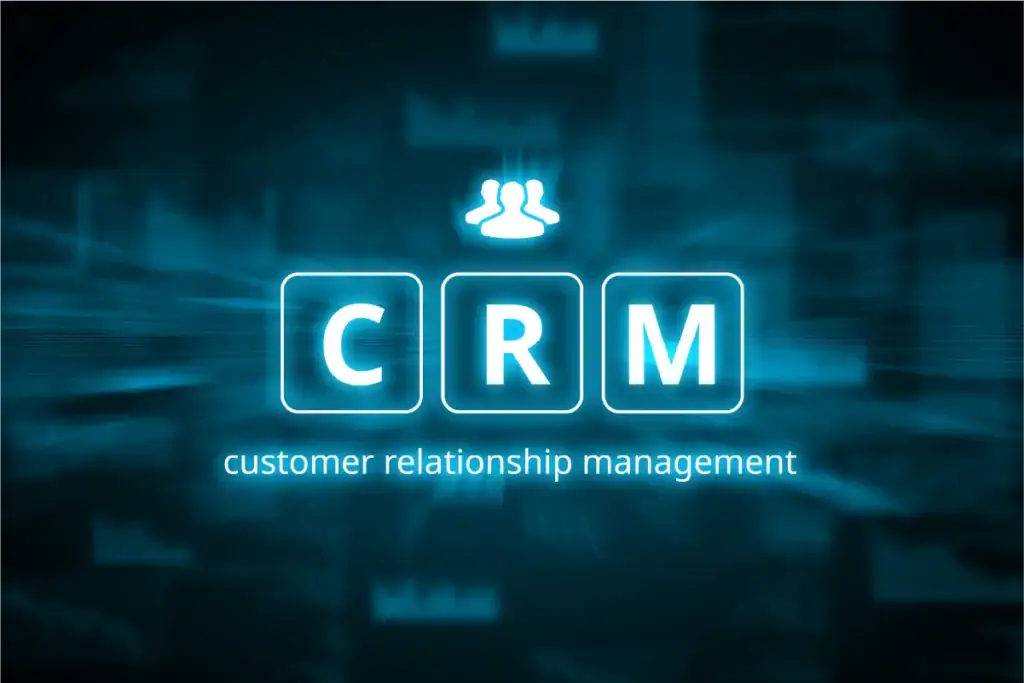
Why CRM Implementation Matters for Your Brand or Business
Strategically implementing a CRM system provides substantial benefits that have a direct influence on your bottom line and market standing. Here’s why it’s a must:
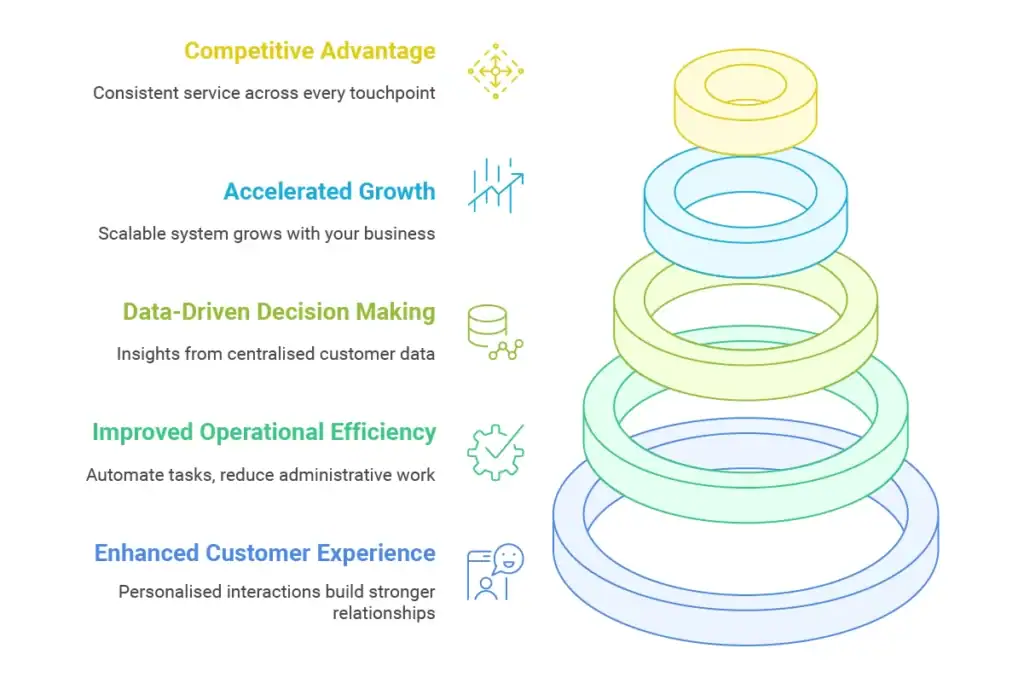
Enhanced Customer Experience
With the entire customer record right in front of them, your staff can provide tailored interactions that develop more lasting relationships. Every staff member can see past conversations, preferences, and purchase history, providing continuity that customers appreciate and comment on.
Competitive Advantage
While competitors are patching together disjointed systems and siloed views of the customer, your company differentiates itself with consistent, intelligent service across all touch points. This edge grows stronger over time as richer, more usable customer data builds up.
Accelerated Growth
A proper CRM implementation puts in place an expandable system that expands in tandem with your business. When you add customers, products, or extend into new markets, your CRM becomes progressively more useful, offering the structure necessary to preserve quality during expanded operations.
Improved Operational Efficiency
Automating repetitive work and standardizing processes ensures that CRM implementation significantly lowers administrative workloads. Salesforces have fewer minutes spent on filling in forms and more time spent in relationship-building, while marketing can design laser-guided campaigns based on true customer behavior instead of conjectures.
For small businesses and entrepreneurs in particular, strategic CRM implementation makes the playing field level as it brings enterprise-class customer management power to companies of all sizes that previously only larger organizations could afford.
Key Components of Strategic CRM Implementation
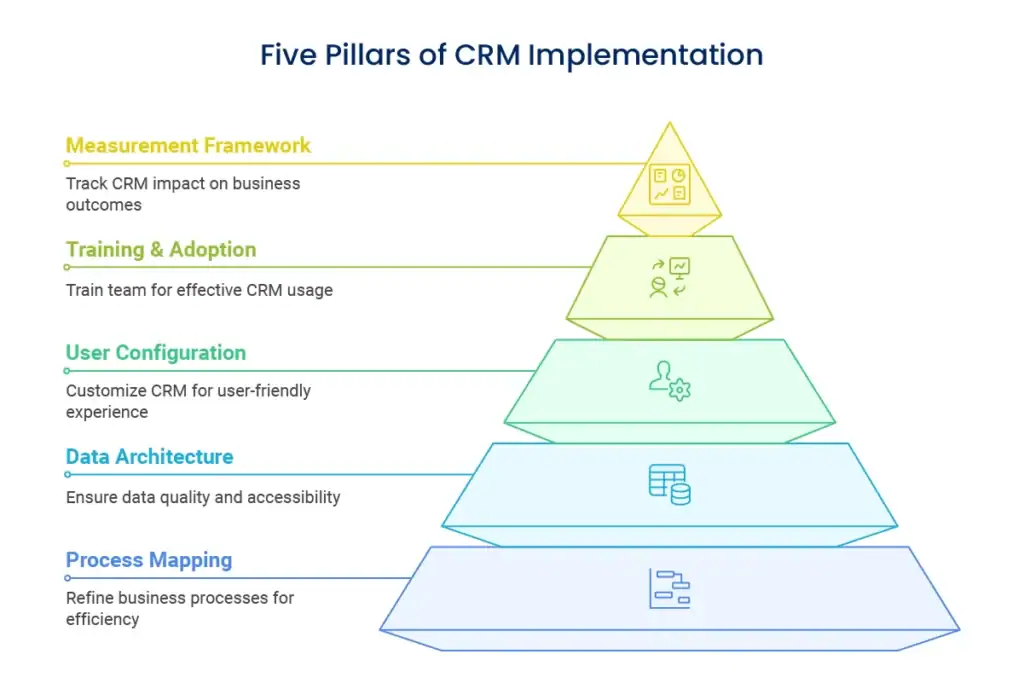
Process Mapping and Optimisation
Prior to setting up any software, we need to learn and streamline your current business processes. This is done through documenting how leads are created, qualified, and closed, how customer service inquiries are addressed, and how data move across departments.
The intention is not to digitise only flawed procedures but to enhance them. By tracing existing workflows and marking friction points, we can structure streamlined procedures which cut out duplications and ensure a smooth customer experience. This basis guarantees that your CRM refines rather than encumbers your business.
Process mapping is especially useful for business operations automation, producing written processes that can be optimized systematically in the long run.
Data Architecture and Integration Strategy
After you’ve developed your strategic framework, the discovery process translates business goals into design needs:
- Competitor research to determine areas of differentiation
- Content audit and information architecture planning
- Technical requirements analysis
- Budget and timeline planning
This stage establishes the blueprint for your project, establishing clear expectations and deliverables. It’s where you decide what technology stack will suit your requirements best and what content should be prioritized.
User-Centric Configuration
The world’s strongest CRM is worthless if your team is not using it. User-centric configuration is about building an experience that simplifies your team’s work instead of loading their plate.
This entails tailoring interfaces to display just the right information, streamlining repetitive data entry, and making sure the system is coherent with how your group really operates. By engaging end-users in configuration, we capture real-world needs that technical requirements may overlook.
Careful design reconciles standardisation (so data is consistent) with flexibility (to fit various roles and ways of working), delivering a system individuals want to use.
Training and Adoption Planning
Technical deployment is only part of the equation—the human factor makes or breaks your CRM investment. Thorough training guarantees that your staff knows how to deploy the system, as well as why it is important to their own success and the success of the company.
Successful adoption planning involves developing role-specific training documents, producing good documentation, identifying internal champions who can assist others, and implementing incentives that drive regular use of CRM.
The aim is to turn the CRM into “one less system to learn” and make everyone’s work easier and more efficient.
Measurement Framework
What is measured is what is managed. A strong measurement system determines the most important indicators of performance that will monitor your CRM’s effect on business results. Those metrics could be adoption rates, data quality measures, gains in process efficiency, and ultimately revenue and customer satisfaction.
By setting baseline metrics prior to implementation andperformance monitoring changes over time, you can clearly prove ROI and pinpoint areas for ongoing improvement. This method is consistent with best-practice performance monitoring and helps your CRM implementation produce quantifiable business outcomes.
One Platform. Infinite Possibilities. Begin CRM Implementation
Step-by-Step Guide to Successful CRM Implementation
Use these tried-and-tested steps to deploy your CRM strategically and create a foundation in customer data that fuels sustainable growth:

Define Clear Business Objectives
Start by saying exactly what success will look like. Do you need to grow customer retention by 15%? Shorten the sales cycle by 20%? Grow cross-selling through the identification of related product opportunities? These particular goals will inform all decisions that follow and enable you to measure success.
Audit Your Current Customer Data Management
Get to know your current data environment before new system implementation. Where does customer data reside today? What are the quality problems? What processes are effective and which could be improved? Having a baseline to work from gives vital background to your implementation plan.
Create Your Sitemap and Content Strategy
Map out every interaction customers have with your company, from initial awareness to post-purchase support. This map identifies where your CRM must capture data and where automation can enhance customer experience. Customer journey mapping facilitates the identification of the moments that significantly affect customer decisions and loyalty.
Create a Detailed Customer Journey Map
Map out every interaction customers have with your company, from initial awareness to post-purchase support. This map identifies where your CRM must capture data and where automation can enhance customer experience. Customer journey mapping facilitates the identification of the moments that significantly affect customer decisions and loyalty.
Design Your Ideal Data Architecture
Decide what customer information you must capture, how it must be organized, and what fields must be required and what fields can be optional. Define standardised definitions of important data points to help ensure data consistency. This structure is now the guide for your CRM setup.
Develop Integration Requirements
Identify which existing systems need to connect with your CRM and document the specific data that should flow between them. Prioritise these integrations based on business impact and technical complexity. Clear integration planning prevents costly rework later.
Configure the System in Phases
Don’t be tempted to roll everything out at once. Implement core functionality that brings immediate benefit, and then build out progressively. The phased approach enables users to develop confidence in the system while creating quick wins that generate momentum and buy-in.
Create Role-Specific Training Plans
Develop customized training materials that address how each department will utilize the CRM in daily operations. Back up generic training with role-specific instruction that demonstrates users how the system simplifies their particular job.
Establish Data Governance Procedures
Put in place well-defined processes for data entry, upkeep, and quality assurance. Define ownership of various data elements and establish frequent audit procedures to ensure data accuracy. Effective governance guarantees that your customer data continues to be reliable as your business grows.
Launch with Strong Executive Sponsorship
Insist that leadership shows visible support for the CRM implementation by actually using the system themselves and rewarding team members who successfully implement it. This support from the top communicates the strategic priority of the effort.
Measure, Refine, and Expand
Start monitoring your established success metrics right after launch. Leverage these findings to optimize processes, resolve adoption issues, and design the next release of functionality. Ongoing refinement turns your CRM from a fixed tool into a dynamic strategic asset.
Recommended Tools and Methods
When implementing a CRM system, selecting the right tools and methodologies can significantly impact your success. Here are some approaches we recommend:
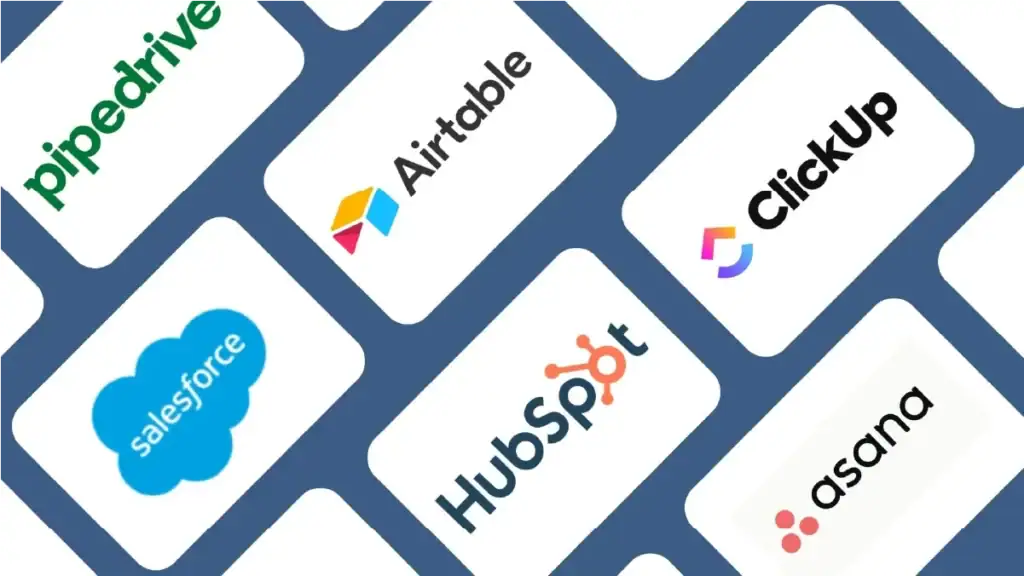
CRM Platforms Suited to Different Business Needs
For Small to Medium Sized Businesses
Solutions such as Zoho CRM or HubSpot have scalable offerings with easy implementation routes and robust automation features. These applications deliver great value with lesser technical overhead.
For Enterprise Organisations
Salesforce and Microsoft Dynamics provide strong customisation support and deep integration features appropriate for sophisticated organisational hierarchies. Both have large ecosystems of third-party applications that allow flexibility for specific needs.
For Online Retail Focused Businesses
CRMs such as Klaviyo or ActiveCampaign provide robust integration with shopping sites and sophisticated customer segmentation tools tailored to online retail environments.
Implementation Methodologies
Agile Implementation
Dividing the CRM project into short sprints enables you to deliver value incrementally with the ability to stay flexible in response to changing requirements. This method is especially useful for companies operating within fast-changing markets.
Process-First Implementation
Prioritising business process optimisation ahead of technical setup means your CRM is building upon and improving rather than just digitising current processes. This approach puts outcome enhancement ahead of feature delivery.
Change Management Framework
Employing formal methods such as ADKAR (Awareness, Desire, Knowledge, Ability, Reinforcement) or Kotter’s 8-Step Process enables the management of human issues surrounding CRM implementation, which usually play a greater role in determining success than do technical considerations.
Data Management Tools
Data Cleaning Applications
Applications such as OpenRefine or Trifacta assist in standardizing and cleansing customer data prior to migration, minimizing the “garbage in, garbage out” syndrome common to most CRM installations.
Integration Platforms
Tools such as Zapier, MuleSoft, or Boomi automate the integration of your CRM with other business applications, eliminating manual data entry and providing a single customer view.
Common CRM Implementation Pitfalls and How to Avoid Them
Even the most carefully planned CRM implementations can face challenges. Here are the most common pitfalls and strategies to avoid them:
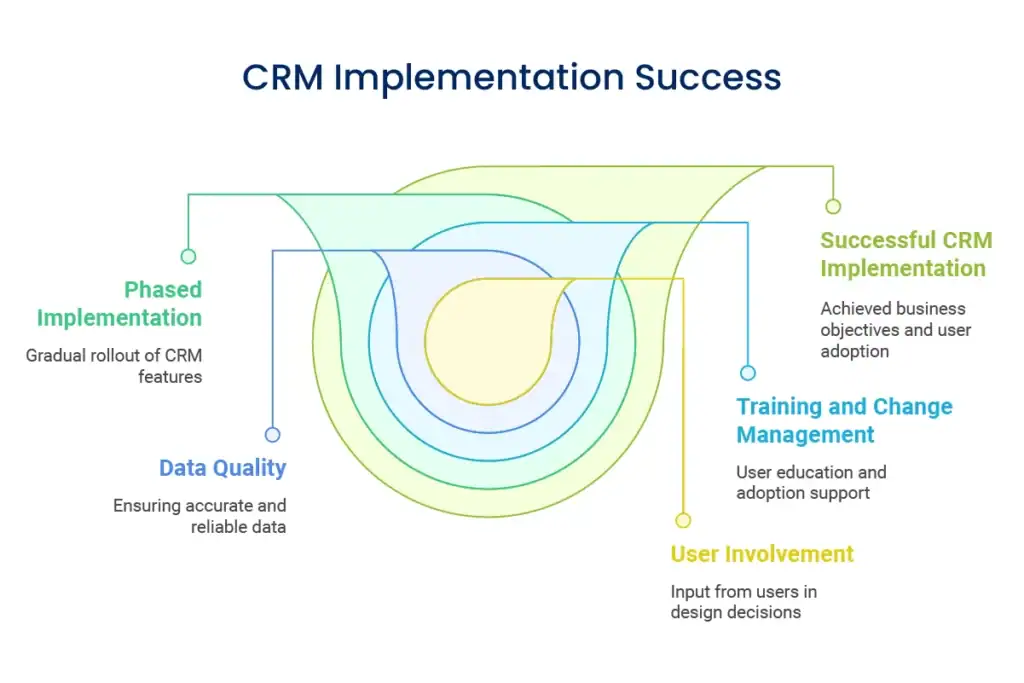
Treating CRM as a Technology Project Rather Than a Business Initiative
The Problem: When implementation is inwardly focused on technical characteristics more than business results, the system that is developed does not end up providing significant value.
The Solution: Start with well-defined business goals and consistently review implementation choices against these objectives. Consider the question “How does this help our customer strategy?” instead of the question “What features do we turn on?”
Insufficient User Involvement in Design Decisions
The Problem: CRM systems that are built without engagement from real users end up causing additional work instead of simplifying processes and translating into ineffective adoption and workarounds.
The Solution: Include representatives of every department in the design process. Implement a feedback loop in which end-users can pilot configurations and provide input before complete deployment.
Neglecting Data Quality
The Problem: Most organisations hurry to move current customer data without first cleansing it, thus inheriting and sometimes even accentuating inherent quality problems.
The Solution: Put money into data cleaning prior to migration and set up regular data governance processes. Keep in mind that bad data causes bad choices, irrespective of how advanced your CRM is.
Inadequate Training and Change Management
The Problem: Even best-case-scenario CRMs collapse when users are not aware of utilizing them efficiently or lack a perceived personal advantage from implementing them.
The Solution: Design robust training programs for various positions. Make strong documentation, provide continuous support, and show successes early for the momentum to build.
Trying to Implement Everything at Once
The Problem: Trying to implement all available CRM functionality at once overloads users and stretches implementation resources too thin.
The Solution: Follow a phased process, beginning with essential functionality that has near-term value. Establish a plan for incrementing features over time based on business need and user willingness.
Don’t Let Leads Slip Away – Deploy Your CRM Now!
Final Thoughts: Your CRM as a Growth Engine
By implementing it strategically, your CRM becomes so much more than a contact database—it becomes the growth driver that drives your entire customer strategy. The customer data foundation you create by deliberate implementation supplies the insights necessary for strategic brand management and smart business decisions.
By orienting your business processes first, and then configuring technology to enable them, you build a system that really makes your team work better instead of creating administrative overhead. What emerges is a single view of the customer that supports personalised interactions, predictive analytics, and competitive edge.
Keep in mind that CRM implementation is not a project but the start of an ongoing process of refinement and expansion. As your company continues to grow, your CRM must also continue to adapt, delivering new capabilities consistently that support your growth plans.
The companies that view CRM implementation as a strategic project and not a technical task are the ones that finally succeed in outperforming their rivals in customer satisfaction, operational excellence, and sustainable growth.
Need Help With Your Custom Website Design?
If you’re embarking on a CRM implementation or seeking to optimize a current system, our experts can assist you in creating a strategic plan that drives actual business results. We are experts at business integration and customer relationship management solutions that fit your unique business objectives and customer strategies.
Reach out to us to learn how we can assist you in creating a customer data foundation that drives sustainable growth for your company.
